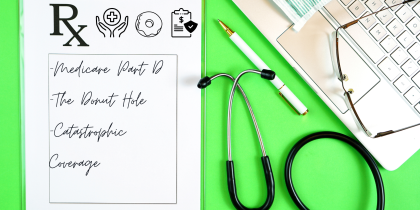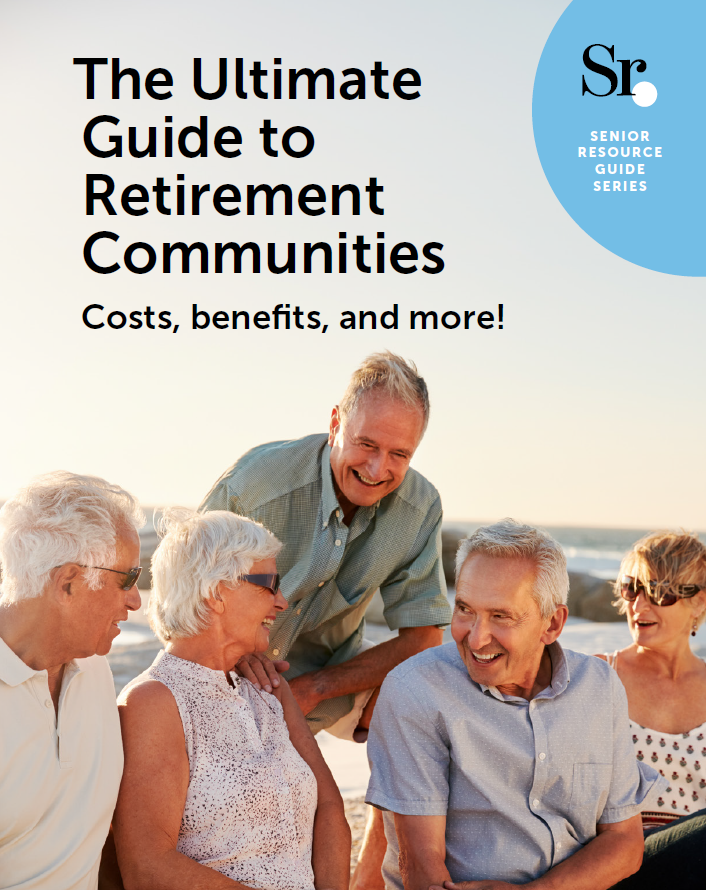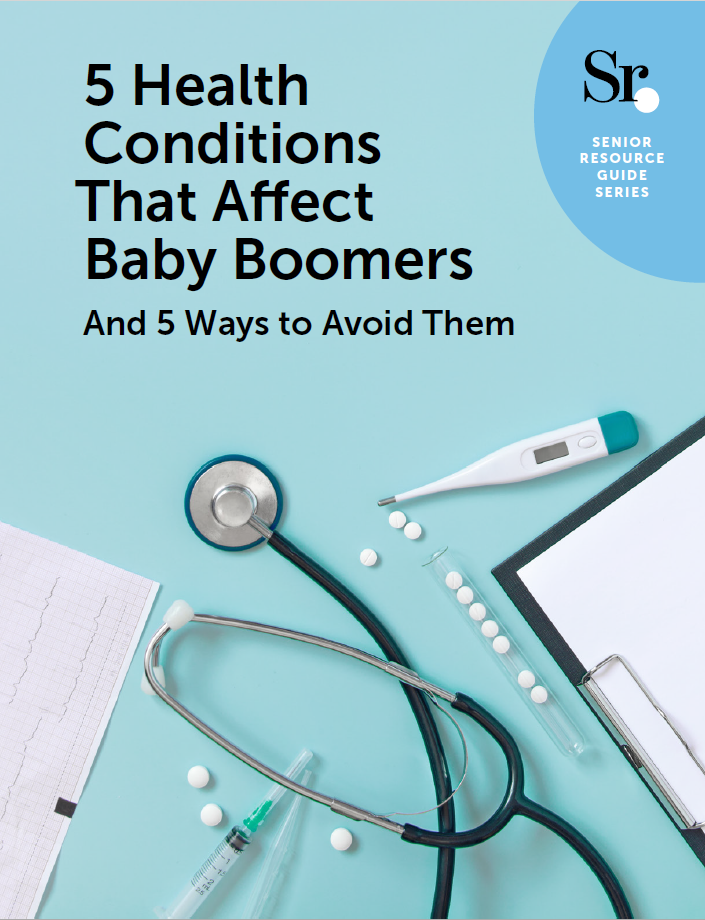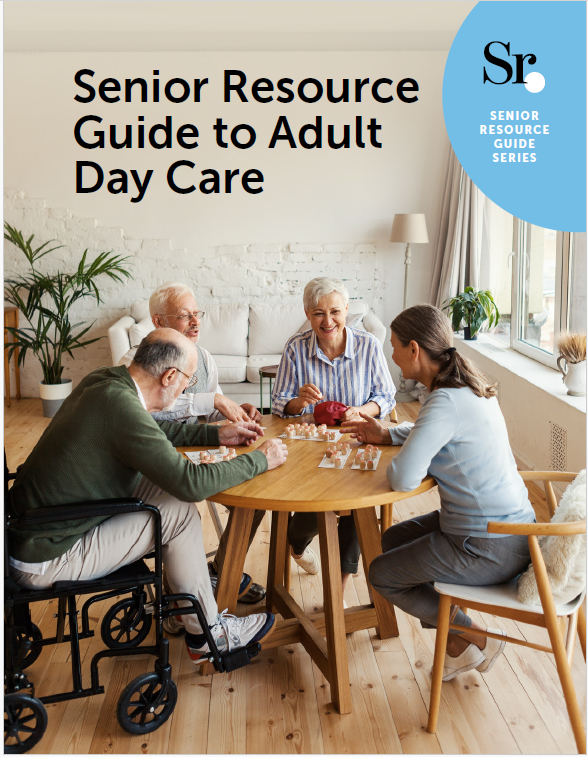5 Ways to Stay Out of The “Donut Hole”
The costs of brand-name prescriptions have risen dramatically. And, if you have a Medicare Part D prescription plan, that could mean BIG expenses when you reach the Coverage Gap. Here’s what you need to know about the infamous Medicare Donut Hole!
View Episode Transcript
Hi, thank you for listening. This is Toni King, and welcome to this Medicare Moments podcast. You know, I took the Medicare and You handbook, and I put it in “people terms”, because people have a hard time trying to understand Medicare, the Medicare and You handbook. So I’m here to help you personalize your Medicare. Today, together, we are discussing Medicare’s “donut hole” and what it is all about. With Medicare, it’s what you don’t know that will hurt you. So let’s go down the maze of Medicare together. Each week, I write an article in the Houston newspaper, and this week, I received a letter from Jennifer from Dallas. And she’s having a terrible time with her mother’s prescription drugs. Here’s what Jennifer says: “Toni, last year, my mother got into the donut hole in October. I can see from the Part D statement she receives that she hit the donut hole in July of this year. Her prescriptions have not changed. She can afford her co-pays of a hundred and eighty dollars a month that she pays to the pharmacy. The monthly Part D statement now says that her prescription drug retail cost is eight hundred and two dollars a month. Here’s what Jennifer says: “I am completely confused. Please give me ideas to help me control the donut hole cost. How can I keep my mother from not getting in it as soon as she is? Thanks, Jennifer from Dallas.” Well, Jennifer, all I can say is that the donut hole is not fun. Your mother’s prescription drug problem is a typical problem nationwide, since the cost of brand name prescription drugs have risen dramatically. Your mother can afford her hundred and eighty dollar co-pays, but has no idea that the actual cost of her prescriptions—both generic and brand name—total eight hundred and two dollars a month. Once the retail cost of her prescription drugs completely totals 4,430 dollars—and that is for 2022—then she will enter the infamous penalty. And your mother entered it in July. Let’s discuss what the costs and co-pays are for the Medicare prescription drug plan. Remember, your prescription drug costs change each year, with a January 1st effective date. Let’s discuss the Medicare 2022 Part D costs. So for 2022, Medicare’s initial deductible is four hundred and eighty dollars. That’s the deductible. Medicare’s initial coverage limit—that means your donut hole. Where does it begin? The donut hole begins once the true cost of your drugs has grown to 4,430 in 2022 and your out-of-pocket threshold. Your out-of-pocket—they call it your “true out-of-pocket” or “troop”—is 7,050 in 2022. So, Jennifer—it doesn’t sound like your mother is having a very good time. Your mother must pay 7,050 of the retail price to get out of the donut hole. She doesn’t pay the whole 7,000 dollars. She will pay twenty-five percent of the drug cost. The brand name drug manufacturer will pay seventy percent of the covered brand name and generic drug cost, and the remaining five percent will be paid by the prescription drug plan. So your mother will not pay the whole 7,050 dollars. It is also paid through the brand name drug manufacturer and the Part D plan which she picks. So let’s talk about what happens if your brand name drug is not covered. What are you gonna do? What if your brand name drug is not covered under your specific Part D plan? You will have to pay a hundred percent of that brand name drug. So we advise everyone to make sure that all of your drugs are covered every year under your prescription drug plan, so that you don’t have to pay a hundred percent if your drug is not covered. The cost is twenty-five percent copay when you are in the donut hole. Generics cost less. Unfortunately, many brand name drugs do not have a generic alternative, so you have to use the brand name drug. This is why it is important when choosing a Medicare Part D prescription drug plan—whether you’re enrolling in it for the first time, or during falls annual enrollment period, which is from October 15th through December 7th. Remember—that’s Medicare’s annual enrollment period. To be sure that all of your prescriptions are covered on your Medicare Part D plan, you need to do research prior to enrolling in a Part D plan. Because if you choose the wrong plan, you cannot change until next Medicare annual enrollment period—which is from October 15th to December 7th every year. Many believe that enrolling in a Medicare Advantage Plan versus a standalone prescription drug plan will keep you out of the donut hole—the infamous donut hole—and also keep you from receiving those extra Irma premiums, if your income is over the average limit for Medicare. Let’s discuss Medicare’s two girlfriends, so that you can understand this. Medicare has two girlfriends. One is Maggie, and the other is Irma, which can increase your Medicare Part B and D premiums. If your income reported to the IRS on a previous tax filing from two years prior is over 91,000 dollars as an individual or 182,000 dollars as a couple for 2020, for your modified adjusted gross income—also known as Maggie; girlfriend number one—then your income-related monthly adjusted amount—known as Irma, which is girlfriend number two—will be more. So enrolling in a Medicare Advantage Plan will not change what extra premium you will have to pay. When someone meets Medicare’s girlfriend number two Irma—the income-related monthly adjusted amount—you will know, because you will have to pay Medicare more than the premium quoted for your Medicare Advantage Plan and Medicare Part D plan. Some people think that they’re receiving two premiums, and they may have two Part D plans. No, that’s not how it goes. One premium is for the Medicare Part D plan, and the other premium is for Irma—Medicare’s girlfriend number two, your income-related monthly adjusted amount that you have to pay extra for. Enrolling in a Medicare Advantage Plan, instead of enrolling in original Medicare with a Medicare supplement and a Medicare Part D plan, does not keep Medicare or Social Security from charging those additional Irma premiums for both Medicare Part B and Medicare Part D. You know, Irma Medicare rule went into effect on January 1st, 2011. It’s been here for a while. When the Irma Medicare part D additional premiums began in 2011, many on Medicare were confused because they believed they were paying for two Medicare Part D plans. Like I said before—one premium for the current plan, and a new premium they had never enrolled in. America had no idea, even though Social Security had sent out a notice explaining the Irma increase. And some were considering dropping their Medicare Part D plan. In 2011, or twenty-eleven, our Toni Says Medicare office was flooded with calls and emails asking for help. Because the Medicare and You handbooks are generally mailed out before October 1st, the cost and Medicare part B and D premiums with the Irma increases for that specific year, are not included. Imagine that! Medicare costs and Medicare part B and D premiums, with all of the increases the Irma increases, are generally released around November 10th of each year. January 1st of each year, this process starts all over again. And a new Medicare prescription drug plan, with different costs and deductibles and a new donut hole. And so, the fun starts all over again. Let’s discuss ways to stay out of the donut hole or try and not get into it as quickly. Here are some Toni Says tips to help you stay out of the donut hole. Toni Says tip number one: Visit www.medicare.gov when selecting a Medicare Part D plan, whether it is your first time or you are changing during Medicare Advantage enrollment period in the fall. This is an accurate way to view the cost of drugs. Which prescription drug plan best meets your needs for that year? And the pharmacy that is a preferred pharmacy, and you can get savings from them. Toni Says tip number two: Talk to your primary care doctor, or your specialty doctors, about which brand name drug can be changed to generics. Some brand name drugs do not have a generic, but if they can change you to a generic, then you can have savings and not get into the donut hole as fast. Toni Says tip number three: Get samples from your doctor. If you get a sample, you do not have to put that on your Medicare Part D plan. Amazing, isn’t it? Toni Says tip number four: Look at the different prescription drug programs, such as Good RX or Single Care for inexpensive prescription drugs. Your local grocery store, such as Kroger, Walmart, Costco, Sam’s, HEB. They all have a discount prescription drug program, and you can use those in lieu of putting that cost on your Medicare Part D plan and keep you from getting in the donut hole as fast. I have a reader named Julia, who sent me a story. She was able to save money on her Medicare Part D plan, because she had a generic Parkinson’s med that was costing a fortune. And when she went to her pharmacy—because her doctor had given her a new generic—it was not covered under her plan, and the cost of that generic prescription drug was four hundred sixty dollars a month. And she went to another pharmacy in network and was told that the retail cost of that drug was a hundred ninety nine dollars per month. That’s what she would have had to pay. When a friend told her about Good RX, she looked at Good RX, looked for the coupon, found the lowest pharmacy that Good RX had in their network, and—with the coupon in hand—went to that pharmacy and found out that that drug for Parkinson’s was gonna cost forty three dollars. She could not imagine how her drug went from four hundred and sixty dollars using her Part D plan to a forty three dollar copay using Good RX and just paying directly. You know, something is wrong with our American prescription drug system. And Julie said for me to tell my readers that now they have to get into the game a little more. They have to go out and search for different ways to save money on their prescription drugs. You know, several websites like Good RX, Single Care, grocery stores, pharmacy or your local pharmacy discount program—they can help you. You just have to do your homework. You have to get in the game and fight for yourself. You know, this is what Medicare Moments podcast is all about—helping you understand how to make the most out of your Medicare. So let’s look at Toni Says tip number five: Contact a local medication assistance program. We have one in the Houston area. It’s Texas A & M Medication Assistance Program. Their number is 866-524-1408. And they have helped save 64,000,000 dollars for people with expensive brand name prescription drugs. They have brought them down to affordable prices. They work with you, and the manufacturer, to get them to where you can afford your prescription drugs and do not get in the donut hole as fast. Look online and see if there is a prescription drug assistance program available in your area or your state. And Toni Says tip number six is: sign up for SeniorResource.com newsletter. Or visit: SeniorResource.com. That’s SeniorResource.com. For more Medicare information and to read my Toni Says Medicare articles—if you’ve got a question, or you have a problem and you want some answers—email me at info@ToniSays.com. That’s info@ToniSays.com. I just want to thank you for listening to the Medicare Moments podcast and become part of our Medicare Moments family. And if you still have questions, like I said, we help you personalize your Medicare. We want to make it for you and your family, so it is not difficult. If you need us, you can visit our website. The website is ToniSays.com. That’s ToniSays.com. Thank you for listening to us, and have a great day. Until next time, we will see you later!
Medicare Survival Guide Advanced Edition
Order Medicare Survival Guide Advanced
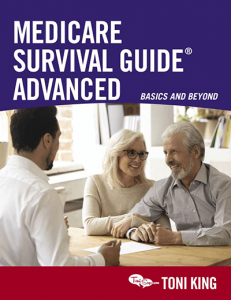
What You Don’t Know Will Hurt You!
Turning 65 in America is a milestone and one of the markers is enrolling in Medicare. But the system is so complicated, and there is a lot of false information out there.
In Toni King’s Medicare Survival Guide Advanced: Basics and Beyond, Toni gives you the critical steps you need to enroll in Medicare properly. Toni shares various situations that she has experienced with her many clients during Medicare consultations, and gives you the information and tools you need to enroll on time to avoid the “famous” Medicare Part B and D penalties.
Medicare Survival Guide Advanced helps you understand Medicare step by step…
Learn How to Enroll the Correct Way
• Still Working Past 65
• Turning 65
• VA Benefits
• Laid-off or Retiring
What Medicare Option Is Best for You
• Medicare Supplement vs. Advantage
• Losing Retirement Benefits
How to Avoid
• The Donut Hole
• Part B Penalties
• Part D IRMAA Penalties
If you are enrolling in Medicare and are confused by the commercials and telemarketers, or from the information that well-meaning friends or family members give, let Toni guide you through the maze of Medicare. Order TODAY!
No post found!
Popular Articles About Medicare Moments
Originally published September 30, 2022

